Introduction to Managerial Accounting: Ethical Standards and Analysis
VerifiedAdded on 2023/06/10
|12
|1760
|237
Report
AI Summary
This assignment provides a comprehensive overview of managerial accounting, focusing on ethical standards and financial analysis. Part A addresses the Institute of Management Accountants' (IMA) ethical standards, including confidentiality, integrity, competence, and credibility, and applies them to the Middle East Tiles Company. It includes calculations of operating profit using the contribution margin approach, break-even point analysis, sales and production budgets, and a schedule of cost of goods manufactured and sold. Part B discusses the benefits of budgeting for Rose Garden Enterprises, such as planning orientation, profitability review, assumptions review, and performance assessment. It also presents a quarterly income statement and analyzes key performance indicators like profit margin ratio and return on investment, demonstrating the impact of sales revenue and operating expenses on profitability.

Running head: INTRODUCTION TO MANAGERIAL ACCOUNTING
Introduction to Managerial Accounting
Name of the Student:
Name of the University:
Author’s Note:
Course ID:
Introduction to Managerial Accounting
Name of the Student:
Name of the University:
Author’s Note:
Course ID:
Paraphrase This Document
Need a fresh take? Get an instant paraphrase of this document with our AI Paraphraser
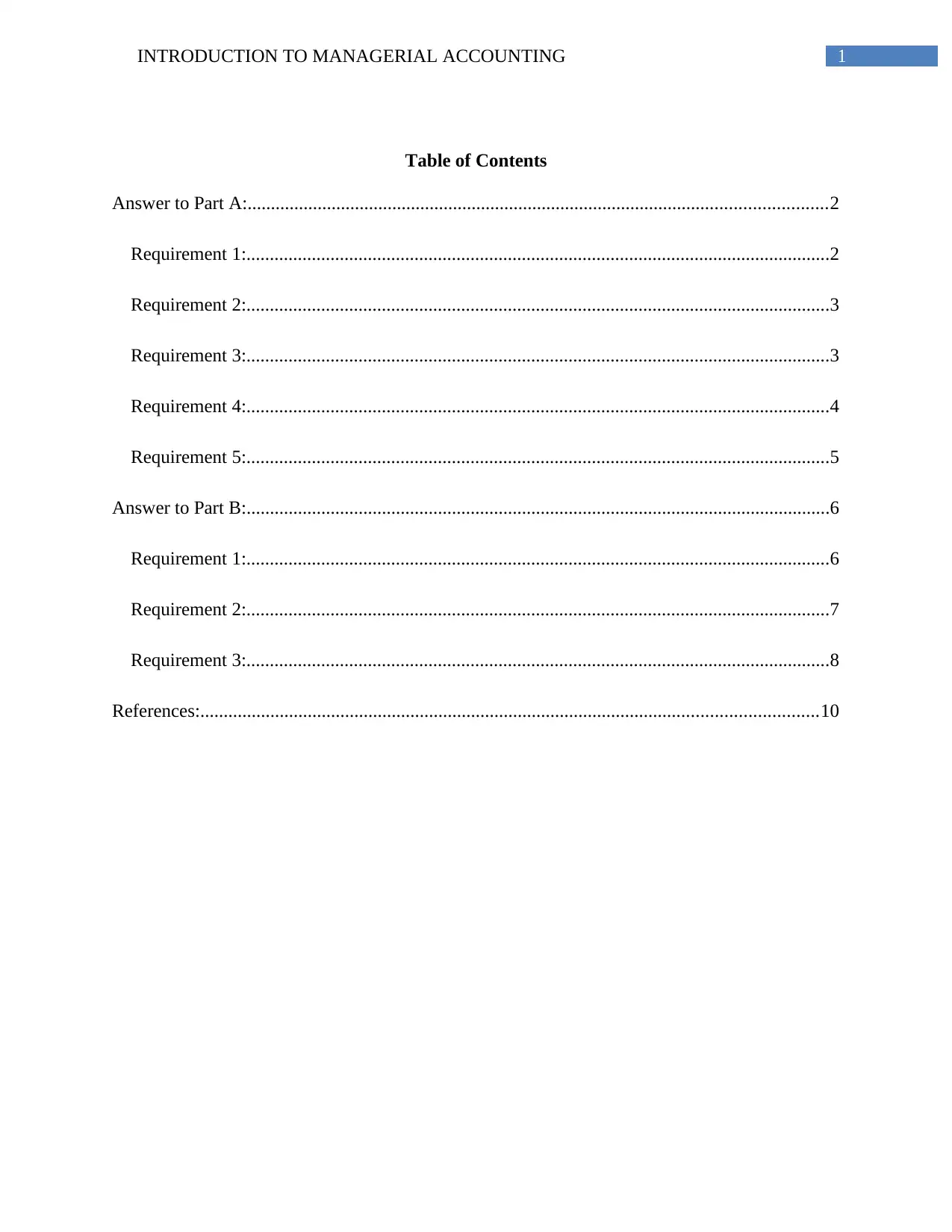
1INTRODUCTION TO MANAGERIAL ACCOUNTING
Table of Contents
Answer to Part A:............................................................................................................................2
Requirement 1:.............................................................................................................................2
Requirement 2:.............................................................................................................................3
Requirement 3:.............................................................................................................................3
Requirement 4:.............................................................................................................................4
Requirement 5:.............................................................................................................................5
Answer to Part B:.............................................................................................................................6
Requirement 1:.............................................................................................................................6
Requirement 2:.............................................................................................................................7
Requirement 3:.............................................................................................................................8
References:....................................................................................................................................10
Table of Contents
Answer to Part A:............................................................................................................................2
Requirement 1:.............................................................................................................................2
Requirement 2:.............................................................................................................................3
Requirement 3:.............................................................................................................................3
Requirement 4:.............................................................................................................................4
Requirement 5:.............................................................................................................................5
Answer to Part B:.............................................................................................................................6
Requirement 1:.............................................................................................................................6
Requirement 2:.............................................................................................................................7
Requirement 3:.............................................................................................................................8
References:....................................................................................................................................10
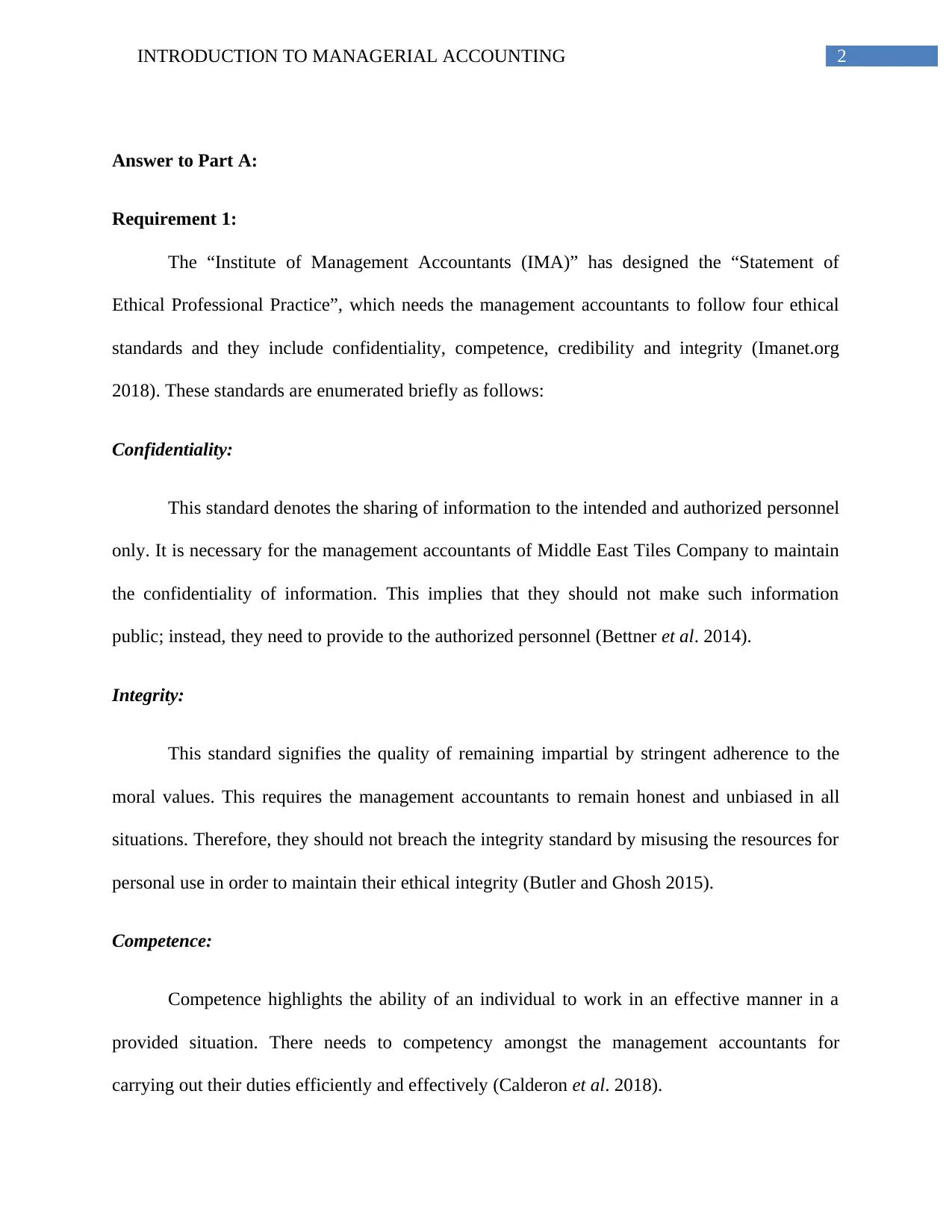
2INTRODUCTION TO MANAGERIAL ACCOUNTING
Answer to Part A:
Requirement 1:
The “Institute of Management Accountants (IMA)” has designed the “Statement of
Ethical Professional Practice”, which needs the management accountants to follow four ethical
standards and they include confidentiality, competence, credibility and integrity (Imanet.org
2018). These standards are enumerated briefly as follows:
Confidentiality:
This standard denotes the sharing of information to the intended and authorized personnel
only. It is necessary for the management accountants of Middle East Tiles Company to maintain
the confidentiality of information. This implies that they should not make such information
public; instead, they need to provide to the authorized personnel (Bettner et al. 2014).
Integrity:
This standard signifies the quality of remaining impartial by stringent adherence to the
moral values. This requires the management accountants to remain honest and unbiased in all
situations. Therefore, they should not breach the integrity standard by misusing the resources for
personal use in order to maintain their ethical integrity (Butler and Ghosh 2015).
Competence:
Competence highlights the ability of an individual to work in an effective manner in a
provided situation. There needs to competency amongst the management accountants for
carrying out their duties efficiently and effectively (Calderon et al. 2018).
Answer to Part A:
Requirement 1:
The “Institute of Management Accountants (IMA)” has designed the “Statement of
Ethical Professional Practice”, which needs the management accountants to follow four ethical
standards and they include confidentiality, competence, credibility and integrity (Imanet.org
2018). These standards are enumerated briefly as follows:
Confidentiality:
This standard denotes the sharing of information to the intended and authorized personnel
only. It is necessary for the management accountants of Middle East Tiles Company to maintain
the confidentiality of information. This implies that they should not make such information
public; instead, they need to provide to the authorized personnel (Bettner et al. 2014).
Integrity:
This standard signifies the quality of remaining impartial by stringent adherence to the
moral values. This requires the management accountants to remain honest and unbiased in all
situations. Therefore, they should not breach the integrity standard by misusing the resources for
personal use in order to maintain their ethical integrity (Butler and Ghosh 2015).
Competence:
Competence highlights the ability of an individual to work in an effective manner in a
provided situation. There needs to competency amongst the management accountants for
carrying out their duties efficiently and effectively (Calderon et al. 2018).
⊘ This is a preview!⊘
Do you want full access?
Subscribe today to unlock all pages.

Trusted by 1+ million students worldwide

3INTRODUCTION TO MANAGERIAL ACCOUNTING
Credibility:
This standard implies the quality of remaining fair, effective and reliable. The
management accountants of the organization have to possess the capability so that its owners
trust them. This could be ensured, if they communicate reliable and authentic information to
them (Epure 2016).
Requirement 2:
Calculation of operating profit for Product A by using contribution margin approach method:
Particulars Total Per Unit
Units produced/sold 10,000
Sales revenue $ 10,000,000 $ 1,000
Less: Variable
expenses
Direct material cost $ 6,000,000 $ 600
Direct labor cost $ 2,000,000 $ 200
Total variable expenses $ 8,000,000 $ 800
Contribution margin $ 2,000,000 $ 200
Fixed costs $ 800,000
Operating profit $ 1,200,000
Requirement 3:
Particulars Total Per Unit
Units produced/sold 10,000
Credibility:
This standard implies the quality of remaining fair, effective and reliable. The
management accountants of the organization have to possess the capability so that its owners
trust them. This could be ensured, if they communicate reliable and authentic information to
them (Epure 2016).
Requirement 2:
Calculation of operating profit for Product A by using contribution margin approach method:
Particulars Total Per Unit
Units produced/sold 10,000
Sales revenue $ 10,000,000 $ 1,000
Less: Variable
expenses
Direct material cost $ 6,000,000 $ 600
Direct labor cost $ 2,000,000 $ 200
Total variable expenses $ 8,000,000 $ 800
Contribution margin $ 2,000,000 $ 200
Fixed costs $ 800,000
Operating profit $ 1,200,000
Requirement 3:
Particulars Total Per Unit
Units produced/sold 10,000
Paraphrase This Document
Need a fresh take? Get an instant paraphrase of this document with our AI Paraphraser
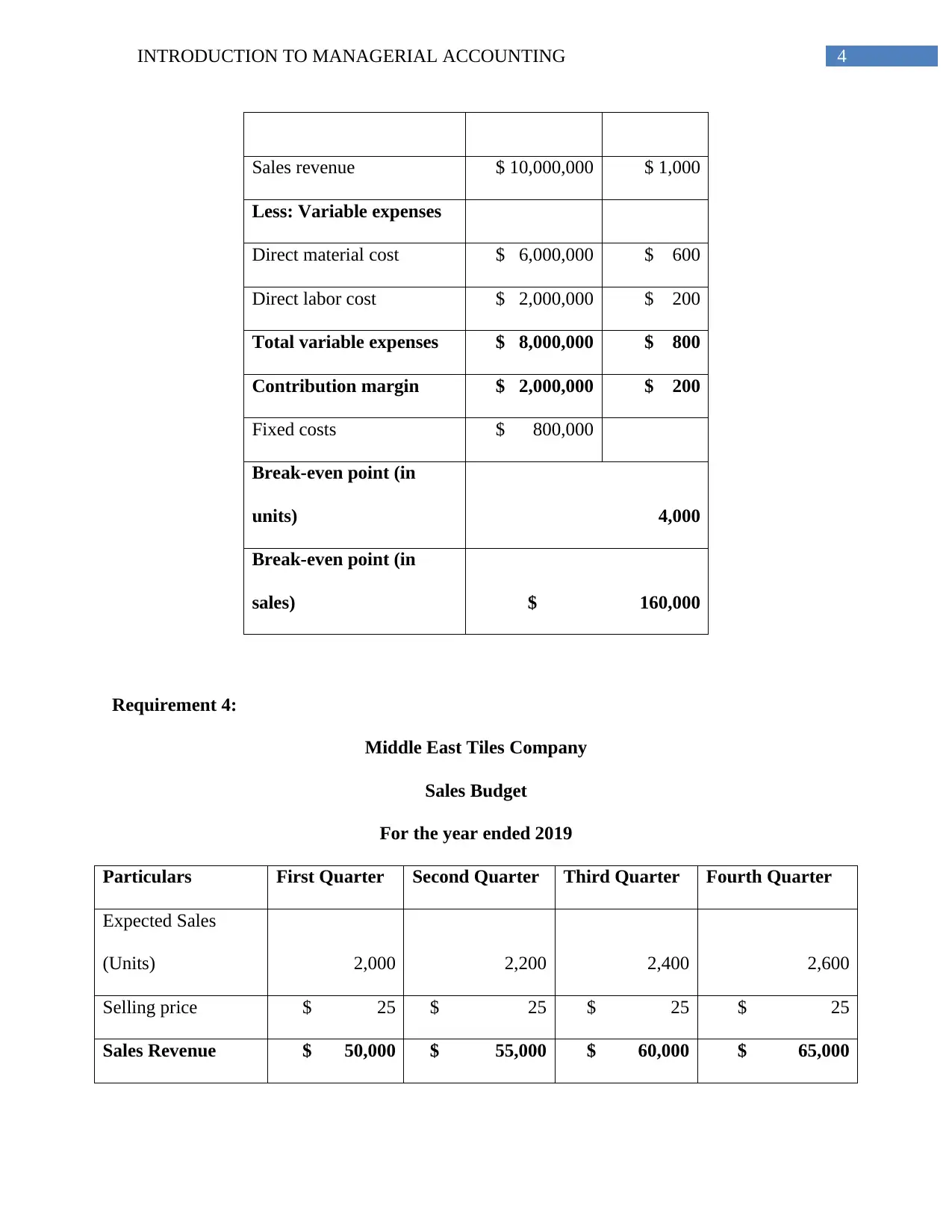
4INTRODUCTION TO MANAGERIAL ACCOUNTING
Sales revenue $ 10,000,000 $ 1,000
Less: Variable expenses
Direct material cost $ 6,000,000 $ 600
Direct labor cost $ 2,000,000 $ 200
Total variable expenses $ 8,000,000 $ 800
Contribution margin $ 2,000,000 $ 200
Fixed costs $ 800,000
Break-even point (in
units) 4,000
Break-even point (in
sales) $ 160,000
Requirement 4:
Middle East Tiles Company
Sales Budget
For the year ended 2019
Particulars First Quarter Second Quarter Third Quarter Fourth Quarter
Expected Sales
(Units) 2,000 2,200 2,400 2,600
Selling price $ 25 $ 25 $ 25 $ 25
Sales Revenue $ 50,000 $ 55,000 $ 60,000 $ 65,000
Sales revenue $ 10,000,000 $ 1,000
Less: Variable expenses
Direct material cost $ 6,000,000 $ 600
Direct labor cost $ 2,000,000 $ 200
Total variable expenses $ 8,000,000 $ 800
Contribution margin $ 2,000,000 $ 200
Fixed costs $ 800,000
Break-even point (in
units) 4,000
Break-even point (in
sales) $ 160,000
Requirement 4:
Middle East Tiles Company
Sales Budget
For the year ended 2019
Particulars First Quarter Second Quarter Third Quarter Fourth Quarter
Expected Sales
(Units) 2,000 2,200 2,400 2,600
Selling price $ 25 $ 25 $ 25 $ 25
Sales Revenue $ 50,000 $ 55,000 $ 60,000 $ 65,000
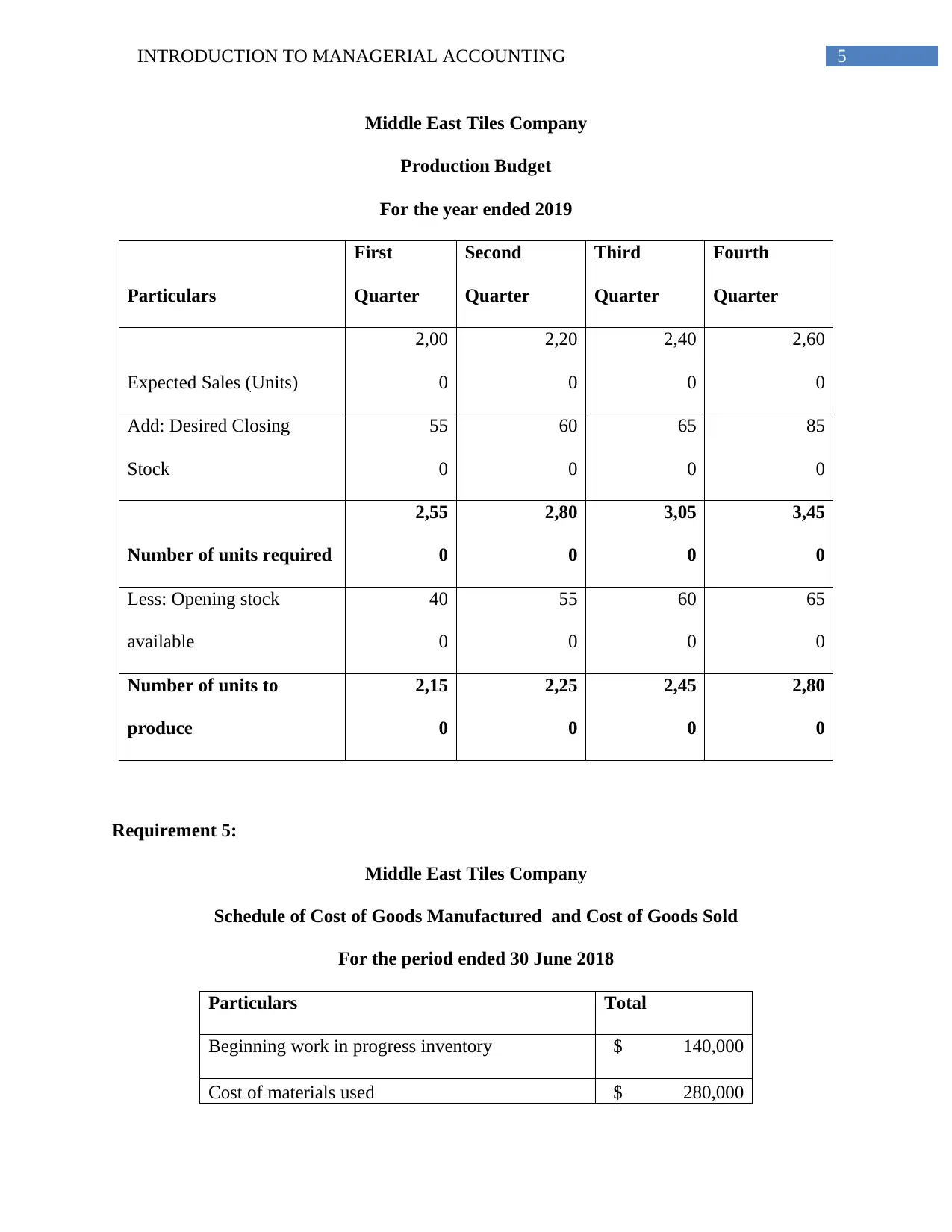
5INTRODUCTION TO MANAGERIAL ACCOUNTING
Middle East Tiles Company
Production Budget
For the year ended 2019
Particulars
First
Quarter
Second
Quarter
Third
Quarter
Fourth
Quarter
Expected Sales (Units)
2,00
0
2,20
0
2,40
0
2,60
0
Add: Desired Closing
Stock
55
0
60
0
65
0
85
0
Number of units required
2,55
0
2,80
0
3,05
0
3,45
0
Less: Opening stock
available
40
0
55
0
60
0
65
0
Number of units to
produce
2,15
0
2,25
0
2,45
0
2,80
0
Requirement 5:
Middle East Tiles Company
Schedule of Cost of Goods Manufactured and Cost of Goods Sold
For the period ended 30 June 2018
Particulars Total
Beginning work in progress inventory $ 140,000
Cost of materials used $ 280,000
Middle East Tiles Company
Production Budget
For the year ended 2019
Particulars
First
Quarter
Second
Quarter
Third
Quarter
Fourth
Quarter
Expected Sales (Units)
2,00
0
2,20
0
2,40
0
2,60
0
Add: Desired Closing
Stock
55
0
60
0
65
0
85
0
Number of units required
2,55
0
2,80
0
3,05
0
3,45
0
Less: Opening stock
available
40
0
55
0
60
0
65
0
Number of units to
produce
2,15
0
2,25
0
2,45
0
2,80
0
Requirement 5:
Middle East Tiles Company
Schedule of Cost of Goods Manufactured and Cost of Goods Sold
For the period ended 30 June 2018
Particulars Total
Beginning work in progress inventory $ 140,000
Cost of materials used $ 280,000
⊘ This is a preview!⊘
Do you want full access?
Subscribe today to unlock all pages.

Trusted by 1+ million students worldwide
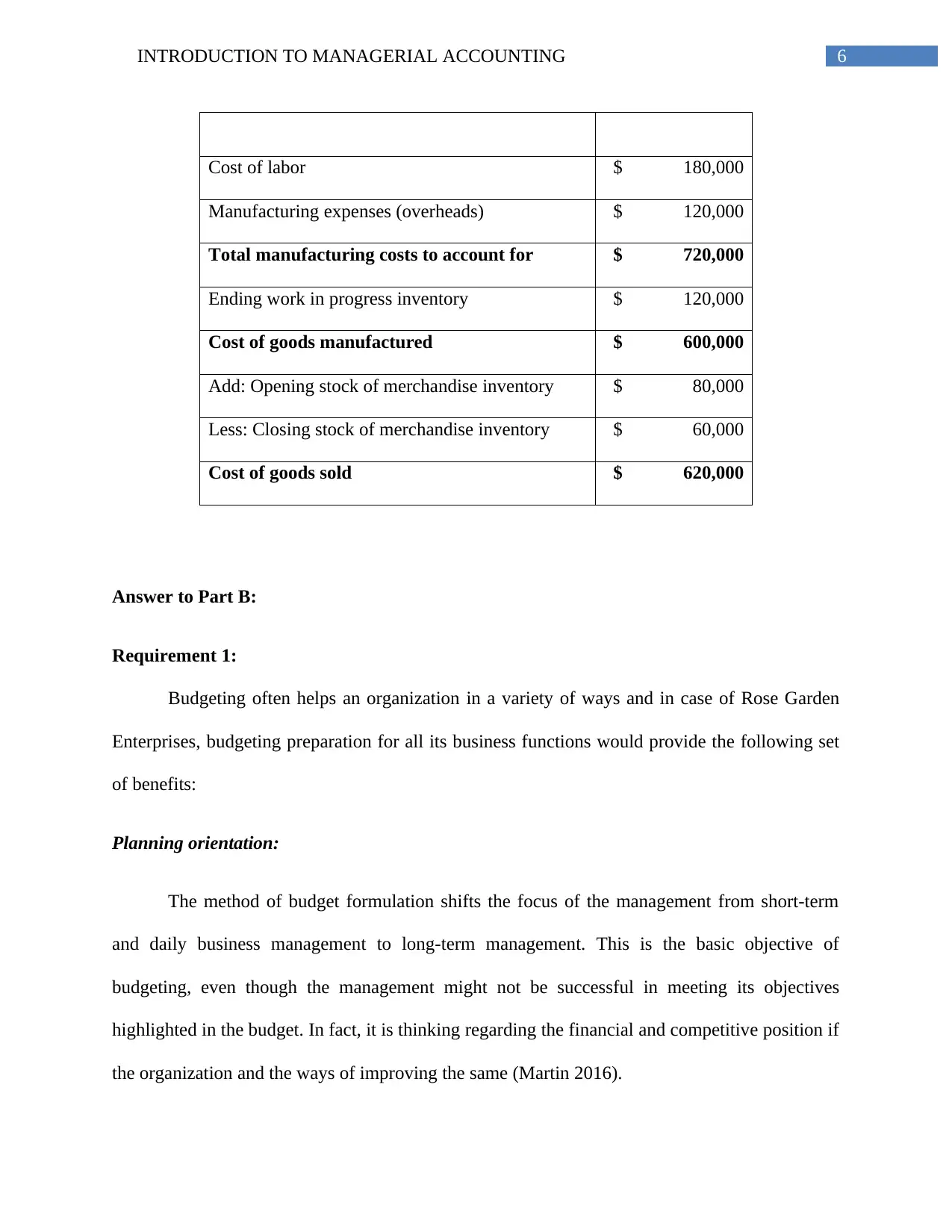
6INTRODUCTION TO MANAGERIAL ACCOUNTING
Cost of labor $ 180,000
Manufacturing expenses (overheads) $ 120,000
Total manufacturing costs to account for $ 720,000
Ending work in progress inventory $ 120,000
Cost of goods manufactured $ 600,000
Add: Opening stock of merchandise inventory $ 80,000
Less: Closing stock of merchandise inventory $ 60,000
Cost of goods sold $ 620,000
Answer to Part B:
Requirement 1:
Budgeting often helps an organization in a variety of ways and in case of Rose Garden
Enterprises, budgeting preparation for all its business functions would provide the following set
of benefits:
Planning orientation:
The method of budget formulation shifts the focus of the management from short-term
and daily business management to long-term management. This is the basic objective of
budgeting, even though the management might not be successful in meeting its objectives
highlighted in the budget. In fact, it is thinking regarding the financial and competitive position if
the organization and the ways of improving the same (Martin 2016).
Cost of labor $ 180,000
Manufacturing expenses (overheads) $ 120,000
Total manufacturing costs to account for $ 720,000
Ending work in progress inventory $ 120,000
Cost of goods manufactured $ 600,000
Add: Opening stock of merchandise inventory $ 80,000
Less: Closing stock of merchandise inventory $ 60,000
Cost of goods sold $ 620,000
Answer to Part B:
Requirement 1:
Budgeting often helps an organization in a variety of ways and in case of Rose Garden
Enterprises, budgeting preparation for all its business functions would provide the following set
of benefits:
Planning orientation:
The method of budget formulation shifts the focus of the management from short-term
and daily business management to long-term management. This is the basic objective of
budgeting, even though the management might not be successful in meeting its objectives
highlighted in the budget. In fact, it is thinking regarding the financial and competitive position if
the organization and the ways of improving the same (Martin 2016).
Paraphrase This Document
Need a fresh take? Get an instant paraphrase of this document with our AI Paraphraser

7INTRODUCTION TO MANAGERIAL ACCOUNTING
Profitability review:
It is observed often that an organization loses its sight of the areas where it is making
money at the time of scramble daily management. With the help of effective budgeting structure,
it would be possible for Rose Garden Enterprises to determine the aspects producing more
money. In this way, it could decide whether to shut down some counterparts or diversify in
others.
Assumptions review:
With the help of budgeting procedure, the management of the organization could think of
the reasons that it is in business along with its significant assumptions regarding its business
environment (Mihăilă 2014). A periodic reassessment of such issues might lead to change in
assumptions and the management might have to alter the ways of business operations.
Performance assessment:
The management of Rose Garden Enterprises could collaborate with its staffs for setting
goals for a budgeted timeframe along with including bonuses and incentives based on their
performance. After this, budgets could be formulated compared to actual reports for providing
staff feedback regarding the ways of progressing towards their goals (Noreen, Brewer and
Garrison 2014). This technique is prevalent with the financial objectives, even though the
operational goals like minimizing the rework rate of the product could be added to budget for
performance assessment.
Requirement 2:
Particulars Quarter 1 Quarter 2 Quarter 3 Quarter 4
Profitability review:
It is observed often that an organization loses its sight of the areas where it is making
money at the time of scramble daily management. With the help of effective budgeting structure,
it would be possible for Rose Garden Enterprises to determine the aspects producing more
money. In this way, it could decide whether to shut down some counterparts or diversify in
others.
Assumptions review:
With the help of budgeting procedure, the management of the organization could think of
the reasons that it is in business along with its significant assumptions regarding its business
environment (Mihăilă 2014). A periodic reassessment of such issues might lead to change in
assumptions and the management might have to alter the ways of business operations.
Performance assessment:
The management of Rose Garden Enterprises could collaborate with its staffs for setting
goals for a budgeted timeframe along with including bonuses and incentives based on their
performance. After this, budgets could be formulated compared to actual reports for providing
staff feedback regarding the ways of progressing towards their goals (Noreen, Brewer and
Garrison 2014). This technique is prevalent with the financial objectives, even though the
operational goals like minimizing the rework rate of the product could be added to budget for
performance assessment.
Requirement 2:
Particulars Quarter 1 Quarter 2 Quarter 3 Quarter 4
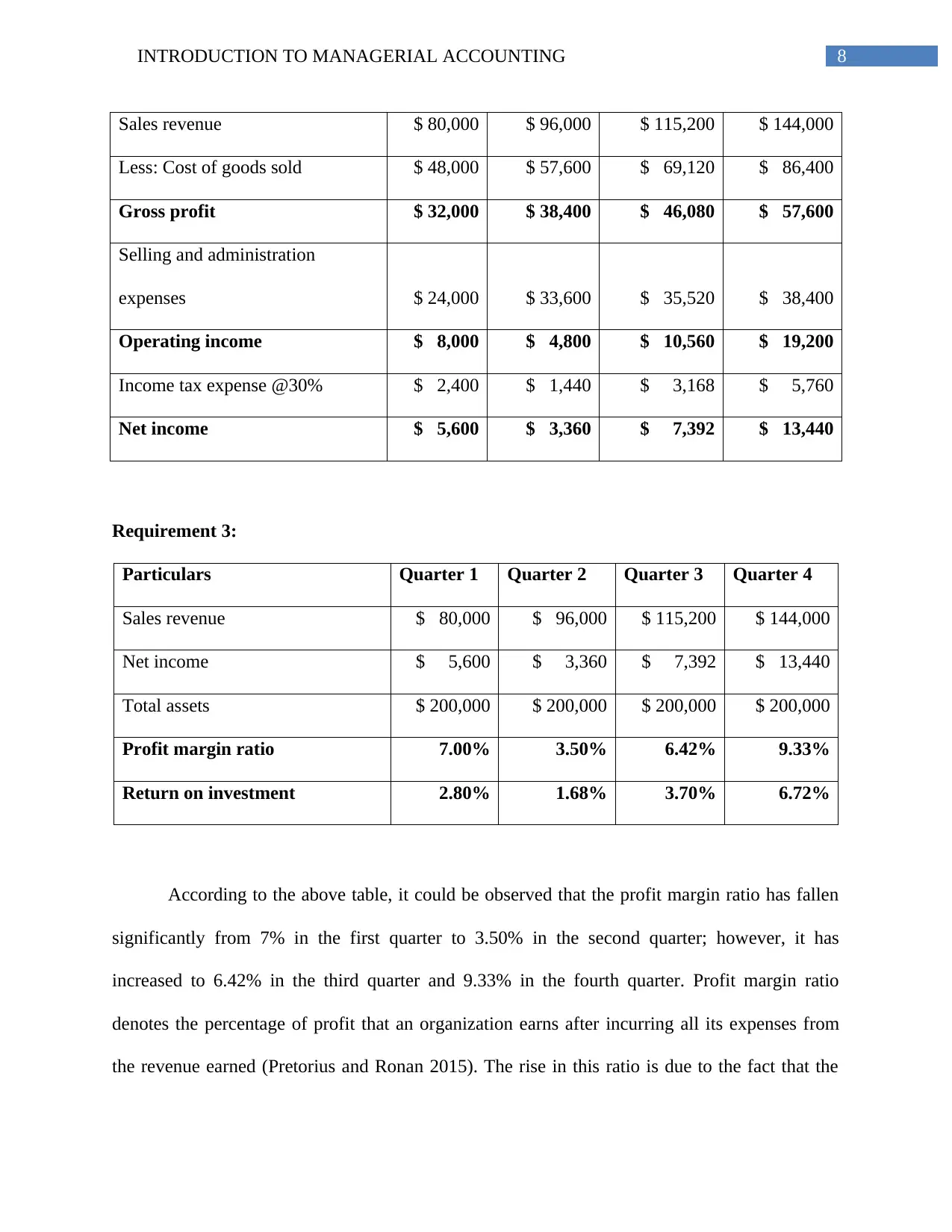
8INTRODUCTION TO MANAGERIAL ACCOUNTING
Sales revenue $ 80,000 $ 96,000 $ 115,200 $ 144,000
Less: Cost of goods sold $ 48,000 $ 57,600 $ 69,120 $ 86,400
Gross profit $ 32,000 $ 38,400 $ 46,080 $ 57,600
Selling and administration
expenses $ 24,000 $ 33,600 $ 35,520 $ 38,400
Operating income $ 8,000 $ 4,800 $ 10,560 $ 19,200
Income tax expense @30% $ 2,400 $ 1,440 $ 3,168 $ 5,760
Net income $ 5,600 $ 3,360 $ 7,392 $ 13,440
Requirement 3:
Particulars Quarter 1 Quarter 2 Quarter 3 Quarter 4
Sales revenue $ 80,000 $ 96,000 $ 115,200 $ 144,000
Net income $ 5,600 $ 3,360 $ 7,392 $ 13,440
Total assets $ 200,000 $ 200,000 $ 200,000 $ 200,000
Profit margin ratio 7.00% 3.50% 6.42% 9.33%
Return on investment 2.80% 1.68% 3.70% 6.72%
According to the above table, it could be observed that the profit margin ratio has fallen
significantly from 7% in the first quarter to 3.50% in the second quarter; however, it has
increased to 6.42% in the third quarter and 9.33% in the fourth quarter. Profit margin ratio
denotes the percentage of profit that an organization earns after incurring all its expenses from
the revenue earned (Pretorius and Ronan 2015). The rise in this ratio is due to the fact that the
Sales revenue $ 80,000 $ 96,000 $ 115,200 $ 144,000
Less: Cost of goods sold $ 48,000 $ 57,600 $ 69,120 $ 86,400
Gross profit $ 32,000 $ 38,400 $ 46,080 $ 57,600
Selling and administration
expenses $ 24,000 $ 33,600 $ 35,520 $ 38,400
Operating income $ 8,000 $ 4,800 $ 10,560 $ 19,200
Income tax expense @30% $ 2,400 $ 1,440 $ 3,168 $ 5,760
Net income $ 5,600 $ 3,360 $ 7,392 $ 13,440
Requirement 3:
Particulars Quarter 1 Quarter 2 Quarter 3 Quarter 4
Sales revenue $ 80,000 $ 96,000 $ 115,200 $ 144,000
Net income $ 5,600 $ 3,360 $ 7,392 $ 13,440
Total assets $ 200,000 $ 200,000 $ 200,000 $ 200,000
Profit margin ratio 7.00% 3.50% 6.42% 9.33%
Return on investment 2.80% 1.68% 3.70% 6.72%
According to the above table, it could be observed that the profit margin ratio has fallen
significantly from 7% in the first quarter to 3.50% in the second quarter; however, it has
increased to 6.42% in the third quarter and 9.33% in the fourth quarter. Profit margin ratio
denotes the percentage of profit that an organization earns after incurring all its expenses from
the revenue earned (Pretorius and Ronan 2015). The rise in this ratio is due to the fact that the
⊘ This is a preview!⊘
Do you want full access?
Subscribe today to unlock all pages.

Trusted by 1+ million students worldwide
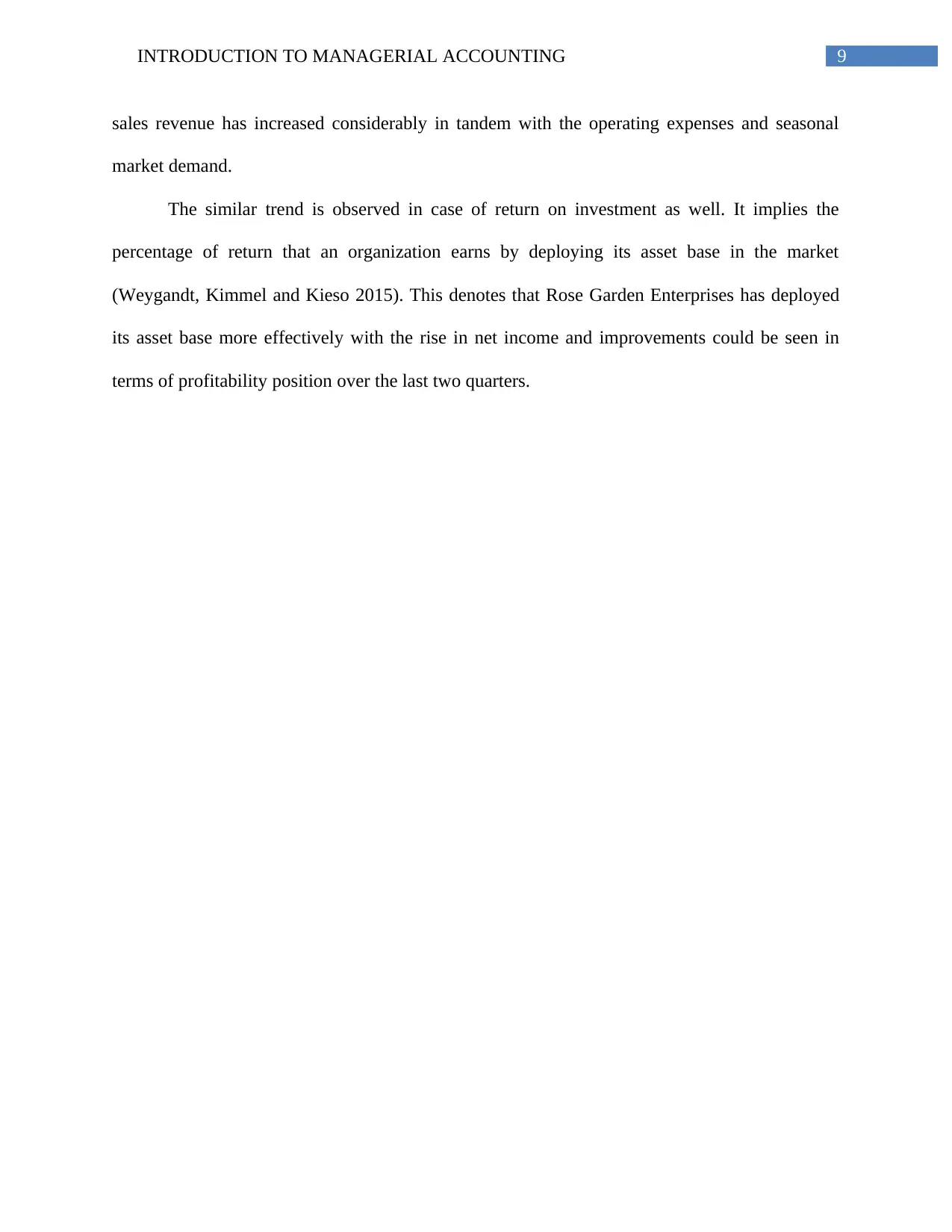
9INTRODUCTION TO MANAGERIAL ACCOUNTING
sales revenue has increased considerably in tandem with the operating expenses and seasonal
market demand.
The similar trend is observed in case of return on investment as well. It implies the
percentage of return that an organization earns by deploying its asset base in the market
(Weygandt, Kimmel and Kieso 2015). This denotes that Rose Garden Enterprises has deployed
its asset base more effectively with the rise in net income and improvements could be seen in
terms of profitability position over the last two quarters.
sales revenue has increased considerably in tandem with the operating expenses and seasonal
market demand.
The similar trend is observed in case of return on investment as well. It implies the
percentage of return that an organization earns by deploying its asset base in the market
(Weygandt, Kimmel and Kieso 2015). This denotes that Rose Garden Enterprises has deployed
its asset base more effectively with the rise in net income and improvements could be seen in
terms of profitability position over the last two quarters.
Paraphrase This Document
Need a fresh take? Get an instant paraphrase of this document with our AI Paraphraser

10INTRODUCTION TO MANAGERIAL ACCOUNTING
References:
Bettner, M., Williams, J., Haka, S. and Carcello, J., 2014. Financial & Managerial Accounting.
Butler, S.A. and Ghosh, D., 2015. Individual differences in managerial accounting judgments
and decision making. The British Accounting Review, 47(1), pp.33-45.
Calderon, T., Hesford, J.W., Mangin, N. and Pizzini, M., 2018. Sunrise Hotels: An integrated
managerial accounting teaching case. Journal of Accounting Education.
Epure, M., 2016. Benchmarking for routines and organizational knowledge: a managerial
accounting approach with performance feedback. Journal of Productivity Analysis, 46(1), pp.87-
107.
Imanet.org., 2018. [online] Available at: https://www.imanet.org/career-resources/ethics-center?
ssopc=1 [Accessed 19 Jul. 2018].
Martin, J.R., 2016. Management Accounting: Concepts, Techniques & Controversial Issues,
Chapter 1, Introduction to Managerial Accounting, Cost Accounting and Cost Management
Systems.
Mihăilă, M., 2014. Managerial accounting and decision making, in energy industry. Procedia-
Social and Behavioral Sciences, 109, pp.1199-1202.
Noreen, E.W., Brewer, P.C. and Garrison, R.H., 2014. Managerial accounting for managers.
New York: McGraw-Hill/Irwin.
Pretorius, A. and Ronan, M. eds., 2015. Managerial Accounting and Financial Management.
Oxford University Press.
References:
Bettner, M., Williams, J., Haka, S. and Carcello, J., 2014. Financial & Managerial Accounting.
Butler, S.A. and Ghosh, D., 2015. Individual differences in managerial accounting judgments
and decision making. The British Accounting Review, 47(1), pp.33-45.
Calderon, T., Hesford, J.W., Mangin, N. and Pizzini, M., 2018. Sunrise Hotels: An integrated
managerial accounting teaching case. Journal of Accounting Education.
Epure, M., 2016. Benchmarking for routines and organizational knowledge: a managerial
accounting approach with performance feedback. Journal of Productivity Analysis, 46(1), pp.87-
107.
Imanet.org., 2018. [online] Available at: https://www.imanet.org/career-resources/ethics-center?
ssopc=1 [Accessed 19 Jul. 2018].
Martin, J.R., 2016. Management Accounting: Concepts, Techniques & Controversial Issues,
Chapter 1, Introduction to Managerial Accounting, Cost Accounting and Cost Management
Systems.
Mihăilă, M., 2014. Managerial accounting and decision making, in energy industry. Procedia-
Social and Behavioral Sciences, 109, pp.1199-1202.
Noreen, E.W., Brewer, P.C. and Garrison, R.H., 2014. Managerial accounting for managers.
New York: McGraw-Hill/Irwin.
Pretorius, A. and Ronan, M. eds., 2015. Managerial Accounting and Financial Management.
Oxford University Press.

11INTRODUCTION TO MANAGERIAL ACCOUNTING
Weygandt, J.J., Kimmel, P.D. and Kieso, D.E., 2015. Financial & managerial accounting. John
Wiley & Sons.
Weygandt, J.J., Kimmel, P.D. and Kieso, D.E., 2015. Financial & managerial accounting. John
Wiley & Sons.
⊘ This is a preview!⊘
Do you want full access?
Subscribe today to unlock all pages.

Trusted by 1+ million students worldwide
1 out of 12
Your All-in-One AI-Powered Toolkit for Academic Success.
+13062052269
info@desklib.com
Available 24*7 on WhatsApp / Email
![[object Object]](/_next/static/media/star-bottom.7253800d.svg)
Unlock your academic potential
Copyright © 2020–2025 A2Z Services. All Rights Reserved. Developed and managed by ZUCOL.


